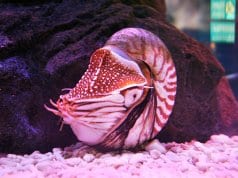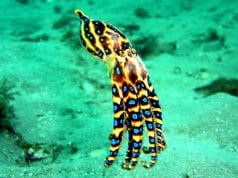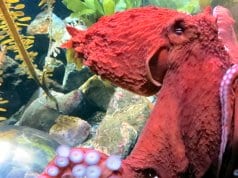Deep beneath the ocean’s surface, where sunlight never penetrates and pressures are immense, dwells a creature of mythic appearance and scientific marvel: the Vampire Squid. Far from the bloodthirsty monster its name might suggest, this enigmatic cephalopod is a gentle scavenger, a living fossil, and a master of survival in one of Earth’s most extreme environments. Join us on a journey into the abyssal realm to uncover the secrets of Vampyroteuthis infernalis, the “vampire squid from hell.”
Unveiling the Enigma: What is a Vampire Squid?
Despite its evocative name, the Vampire Squid is neither a true squid nor a true octopus. It occupies its own unique taxonomic order, Vampyromorphida, making it a distinct and ancient lineage within the cephalopod family tree. This classification highlights its evolutionary significance, representing a branch that diverged from both octopuses and squids millions of years ago.
Visually, the Vampire Squid is a striking creature. It typically measures up to 28 centimeters (about 11 inches) in total length, with a gelatinous body that can range in color from velvety black to reddish-black. Its most distinctive features are its large, bulbous eyes, which are proportionally the largest of any animal relative to its body size, and its eight arms connected by a dark, cloak-like webbing. Two small, paddle-shaped fins protrude from its mantle, providing propulsion.
Perhaps its most captivating trait is its mastery of bioluminescence. The Vampire Squid is covered in light-producing organs called photophores, which it can control to create dazzling displays. These range from simple flashes to complex patterns, used for camouflage, communication, and defense in the perpetual darkness of its habitat.
A Home in the Abyss: The Vampire Squid’s Deep-Sea Habitat
The Vampire Squid is an inhabitant of the mesopelagic and bathypelagic zones, typically found at depths ranging from 600 to 900 meters (2,000 to 3,000 feet), though it has been observed as deep as 3,000 meters (10,000 feet). This region is famously known as the “oxygen minimum zone” (OMZ).
- Depth: Primarily 600-900 meters, but can extend to 3,000 meters.
- Temperature: Consistently cold, typically 2-6°C (35-43°F).
- Pressure: Immense, hundreds of times greater than surface pressure.
- Oxygen Levels: Critically low, often less than 5% saturation. This is a key defining feature of its habitat.
- Light: Absolutely no sunlight penetrates these depths, making it a world of perpetual darkness.
This extreme environment is hostile to most life, yet the Vampire Squid thrives here, thanks to a suite of remarkable adaptations. Its ability to survive in the OMZ is a testament to its unique physiology, including a low metabolic rate and specialized blood pigments that efficiently bind oxygen.
For an animal lover hoping to find a Vampire Squid in the wild, the reality is that such an encounter is virtually impossible without highly specialized deep-sea submersibles. These creatures live far beyond the reach of divers or even remotely operated vehicles (ROVs) not designed for extreme depths. A casual encounter, especially for a hiker, is quite literally out of this world, as they are exclusively marine and deep-dwelling.
The Evolutionary Journey: A Living Fossil’s Tale
The Vampire Squid is often referred to as a “living fossil” because its lineage dates back approximately 300 million years, making it one of the oldest surviving cephalopod groups. Its unique position in the tree of life, as the sole surviving member of the order Vampyromorphida, provides invaluable insights into the evolution of both octopuses and squids.
Scientists believe that the Vampyromorphida diverged from other cephalopods before the split between octopuses (Octopoda) and squids (Teuthida). It possesses characteristics that are a mosaic of both groups, along with features entirely unique to itself. For instance, it has eight arms like an octopus, but also two specialized filaments that are homologous to the retractile tentacles of squids, though used differently. Its internal shell, or gladius, is also distinct, providing clues to ancient cephalopod anatomy.
Studying the Vampire Squid helps researchers understand the ancestral traits of modern cephalopods and how different evolutionary pressures led to the diverse forms we see today. Its persistence in the deep sea suggests that its adaptations to this stable, yet challenging, environment have been remarkably successful over geological timescales.
A Unique Palate: The Vampire Squid’s Diet
Unlike its predatory cephalopod relatives, the Vampire Squid is a detritivore, meaning it feeds on detritus. Its primary food source is “marine snow,” a continuous shower of organic particles that drifts down from the upper, sunlit layers of the ocean. This marine snow consists of dead plankton, fecal pellets, discarded larval casings, and other organic debris.
The Vampire Squid employs a fascinating feeding strategy. It extends its two long, sticky filaments, which are covered in tiny cilia. These filaments act like fishing lines, sweeping through the water to collect particles of marine snow. Once enough detritus has accumulated, the Vampire Squid retracts the filaments, scrapes the food into its mouth with its arms, and consumes it. This method is highly energy-efficient, perfectly suited for its low-metabolism lifestyle in an energy-poor environment.
This specialized diet makes the Vampire Squid a crucial component of the deep-sea ecosystem, playing a vital role in recycling organic matter and transferring nutrients from the surface waters to the deep ocean floor.
Life’s Cycle in the Deep: Mating and Reproduction
The reproductive processes of deep-sea creatures are often slow and energy-intensive, and the Vampire Squid is no exception. Observations suggest a unique reproductive strategy known as iteroparity, where females reproduce multiple times over their lifespan, rather than a single, massive reproductive event (semelparity) common in many cephalopods.
- Mating: Details of courtship are largely unknown due to the challenges of observation in their natural habitat. However, it is believed that males transfer spermatophores (sperm packets) to the female.
- Egg Production: Females produce a relatively small number of large eggs, approximately 4 millimeters in diameter. These eggs are rich in yolk, providing ample nourishment for the developing embryo.
- Gestation and Hatching: The eggs are thought to develop slowly, possibly over a long period, before hatching into miniature versions of the adults. The hatchlings are already equipped with the basic adult form, including the characteristic fins and arms, though their proportions differ.
- Growth Rate: Growth is extremely slow, a common adaptation to the cold temperatures and limited food resources of the deep sea.
- Lifespan: While precise lifespans are difficult to determine for deep-sea creatures, it is estimated that Vampire Squids can live for several years, possibly up to 8 years or more, given their slow metabolism and growth.
This iteroparous strategy, combined with slow growth and large, yolky eggs, is an adaptation to maximize reproductive success in an environment where resources are scarce and encounters with mates might be infrequent.
Ecosystem Contributions and Interactions
The Vampire Squid’s role in the deep-sea ecosystem is primarily that of a detritivore. By consuming marine snow, it helps to:
- Nutrient Recycling: It processes organic matter, preventing it from simply accumulating on the seafloor and making its nutrients available to other organisms.
- Carbon Sequestration: By consuming and packaging organic carbon, it contributes to the biological pump, moving carbon from surface waters to the deep ocean.
Interactions with other animals are likely limited due to its deep-sea habitat and unique adaptations. Its primary predators are thought to be deep-diving whales, large fish, and possibly other deep-sea cephalopods. However, direct observations of predation are rare.
Its defense mechanisms are also noteworthy:
- “Pineapple” Posture: When threatened, it can invert its webbed arms over its body, exposing sharp, spine-like cirri on the underside of its arms, creating a spiky, intimidating appearance resembling a pineapple.
- Bioluminescent “Ink”: Instead of expelling dark ink like many shallow-water cephalopods, the Vampire Squid can eject a cloud of bioluminescent mucus from the tips of its arms. This glowing cloud disorients predators, allowing the squid to escape into the darkness.
- Camouflage: Its dark coloration helps it blend into the abyssal gloom, and its photophores can be used for counter-illumination, matching the faint light filtering down from above to obscure its silhouette.
The Vampire Squid in Human Culture and Interaction
The Vampire Squid’s interaction with humans is minimal, almost exclusively limited to scientific exploration. It is not a target for commercial fishing, nor does it pose any threat to humans. Encounters are rare and occur only through specialized deep-sea research expeditions using submersibles or remotely operated vehicles (ROVs).
Culturally, its name, “Vampire Squid from Hell,” has cemented its place in popular imagination as a creature of mystery and the deep. It frequently features in documentaries about the deep sea, serving as an iconic representation of the strange and wonderful life found in Earth’s unexplored depths. Its unique appearance and adaptations make it a fascinating subject for scientific illustration, literature, and even video games, where it often inspires fantastical deep-sea monsters.
Fascinating Facts About the Vampire Squid
Here is a collection of intriguing details that highlight the Vampire Squid’s extraordinary nature:
- Giant Eyes: Its eyes are proportionally the largest of any animal, allowing it to detect the faintest flickers of bioluminescence in the deep.
- Blue Blood: Like other cephalopods, the Vampire Squid has hemocyanin in its blood, which contains copper and gives its blood a blue color. This is more efficient at transporting oxygen in cold, low-oxygen environments than hemoglobin.
- No Ink Sac (Traditional): Instead of a dark ink sac, it has specialized bioluminescent glands that produce a glowing mucus cloud for defense.
- Gelatinous Body: Its soft, gelatinous body helps it maintain buoyancy and withstand the immense pressures of its habitat without expending much energy.
- Slow Metabolism: It has one of the lowest metabolic rates among cephalopods, an essential adaptation for survival in an energy-poor environment.
- Unique Filaments: The two long, retractable filaments are unique to its order and are used exclusively for feeding, not for capturing prey or mating.
- Color Changing: While generally dark, it can subtly change its coloration, likely for camouflage or communication.
- Ancient Lineage: It is the sole surviving member of an ancient order, making it a crucial link in understanding cephalopod evolution.
Caring for a Deep-Sea Enigma: The Zookeeper’s Challenge
Keeping a Vampire Squid in captivity is an extraordinary challenge, one that has rarely been successfully achieved for extended periods. The specific environmental requirements of its deep-sea habitat are incredibly difficult and expensive to replicate. For an aspiring zookeeper, understanding these needs is paramount:
- Temperature Control: The water must be kept consistently cold, typically between 2-6°C (35-43°F). Even slight fluctuations can be detrimental.
- Pressure Simulation: While some deep-sea animals can adapt to surface pressure, maintaining high pressure might be beneficial or even necessary for the long-term health of a Vampire Squid. This requires specialized, pressure-resistant aquariums, which are extremely rare and costly.
- Oxygen Levels: The water must have very low oxygen saturation, mimicking the oxygen minimum zone. This is counter-intuitive to typical aquarium practices that aim for high oxygenation.
- Light Conditions: The environment must be kept in perpetual darkness, with only minimal, specialized red or infrared light used for observation, as bright lights would be extremely stressful and damaging.
- Water Quality: Pristine water quality is essential, with careful filtration to remove waste without disturbing the delicate balance of temperature and oxygen.
- Diet: Replicating “marine snow” is a significant hurdle. Zookeepers would need to provide a continuous supply of finely particulate organic matter, such as cultured phytoplankton, zooplankton detritus, or specialized deep-sea food formulations, delivered in a way that mimics its natural feeding method.
- Tank Size and Design: A large, deep tank would be necessary to allow for natural movement and to minimize stress. The tank should have smooth surfaces to prevent injury to its delicate body.
- Minimal Handling: Due to its delicate, gelatinous body and sensitivity to stress, handling should be avoided at all costs.
- Avoid Rapid Changes: Any sudden changes in temperature, pressure, light, or water chemistry could be fatal.
In essence, caring for a Vampire Squid requires a dedicated, state-of-the-art deep-sea research aquarium, a team of highly specialized marine biologists, and substantial financial resources. It is not an animal that can be kept in a conventional public aquarium setting.
Conclusion: A Glimpse into the Deep
The Vampire Squid stands as a testament to life’s incredible adaptability and the enduring mysteries of our planet’s oceans. From its ancient lineage to its ingenious survival strategies in the oxygen minimum zone, every aspect of Vampyroteuthis infernalis offers a window into a world few will ever see. It reminds us that even in the most extreme environments, life finds a way, evolving forms that are both alien and exquisitely beautiful. As we continue to explore the deep sea, who knows what other wonders await discovery, perhaps even more “vampires” from the depths, ready to challenge our understanding of life itself.






![Red Angus Closeup of a beautiful Red Angus cowPhoto by: U.S. Department of Agriculture [pubic domain]https://creativecommons.org/licenses/by/2.0/](https://animals.net/wp-content/uploads/2020/03/Red-Angus-4-100x75.jpg)

